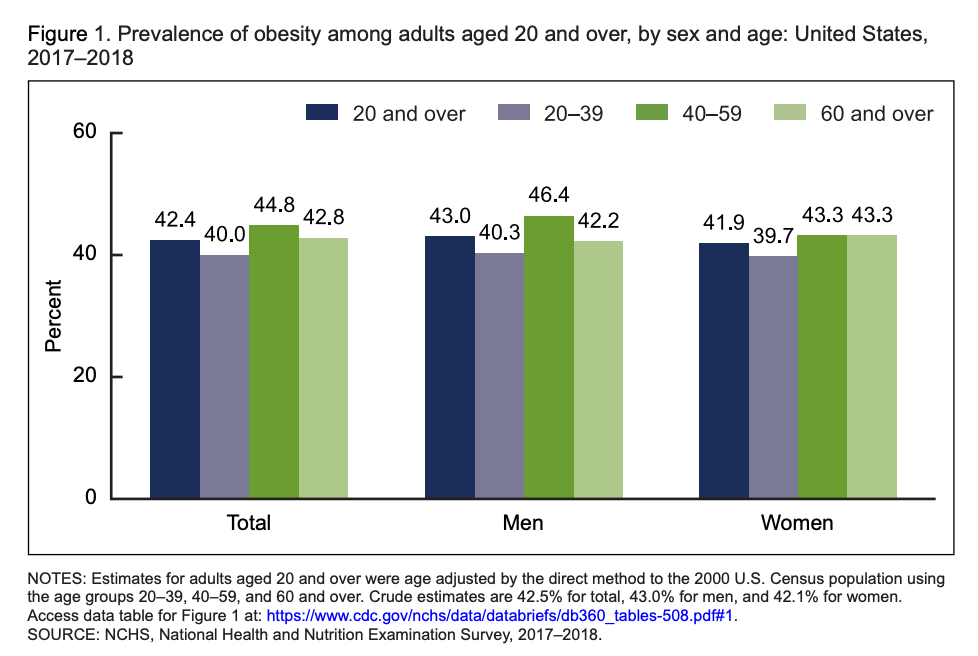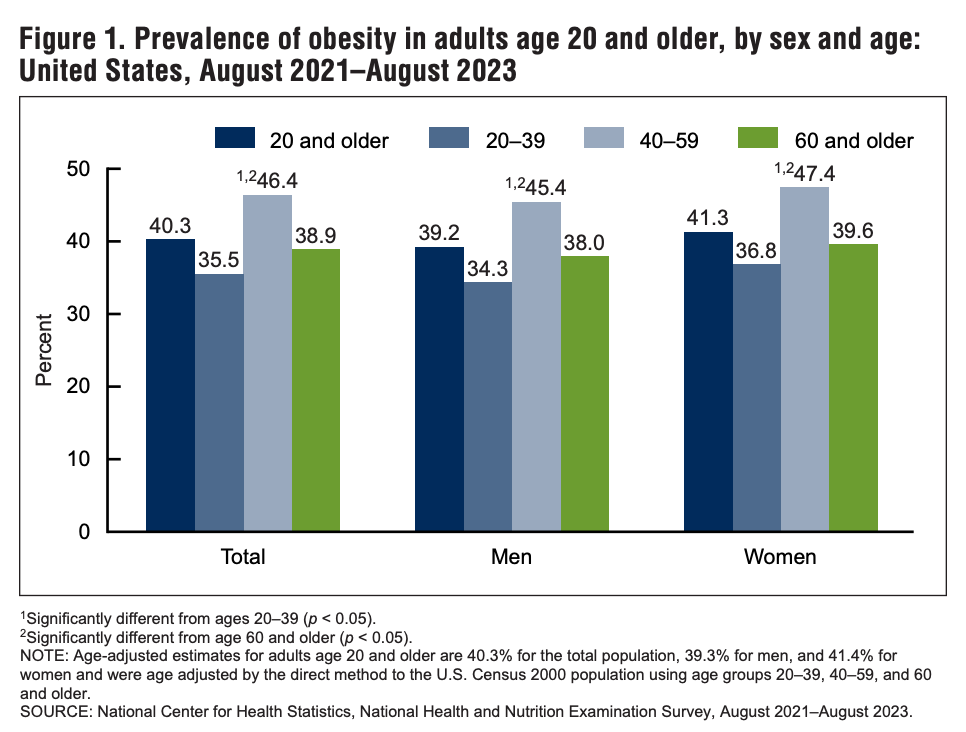Obesity in Women vs. Men in the USA: Key Differences and Health Risks
Obesity continues to be one of the most pressing public health challenges in the United States. Despite signs that overall obesity rates may be stabilizing, the numbers remain alarmingly high—with long-term health consequences for millions of Americans.
According to the CDC, over 40% of adults in the United States are living with obesity. While the burden is shared across genders, recent studies have highlighted important differences in how obesity manifests in men and women, both biologically and behaviorally. This growing focus on obesity in women vs men sheds light on why a one-size-fits-all approach to treatment may not be effective.
In this blog post, we explore the key differences in obesity between men and women in the USA, including prevalence, physiological differences, mental and emotional drivers, and related health risks.
Prevalence of Obesity: A Gender Perspective
Overall Adult Obesity Rates
In the 2017–2018 National Health and Nutrition Examination Survey (NHANES), the age-adjusted prevalence of obesity among U.S. adults reached 42.4%, marking a concerning trend toward higher obesity rates nationwide. Although more recent estimates from 2021–2023 indicate a slight decrease to 40.3%, the percentage remains alarmingly high. This underscores that nearly 2 in every 5 American adults are living with obesity, despite increasing awareness and public health campaigns.
Comparing Men and Women
Gender comparisons reveal relatively similar overall obesity rates, but subtle distinctions persist:
In 2017–2018, obesity prevalence was nearly equivalent among men and women:
- Men: 43.0%
- Women: 41.9%

By 2021–2023, the pattern remained consistent, with a slight decline in men:
- Men: 39.2%
- Women: 41.3%

These figures show that while both genders are significantly affected, women continue to experience slightly higher rates, particularly in more severe forms of obesity.
READ: The Most Obese States in America 2025
Severe Obesity (BMI ≥ 40): A Gender Divide
When examining severe obesity—defined as a body mass index (BMI) of 40 or higher—a marked gender disparity becomes apparent, with women consistently affected at nearly double the rate of men:
- 2017–2018
- Women: 11.5%
- Men: 6.9%
- Women: 11.5%
- 2021–2023
- Women: 12.6%
- Men: 6.8%
- Women: 12.6%
This trend suggests that not only are women more likely to fall into the severely obese category, but the prevalence is also on the rise among women, while remaining relatively stagnant for men.
Obesity by Age Group
Age also plays a significant role in obesity prevalence, with middle-aged adults (ages 40–59) being the most affected across both genders:
- Men (40–59): 46.4%
- Women (40–59): 43.3%
Younger adults (ages 20–39) and older adults (60 and above) showed comparatively lower rates. However, obesity in younger age groups is still a concern, as it can lead to earlier onset of obesity-related conditions like type 2 diabetes, hypertension, and cardiovascular disease.
Obesity by Race and Ethnicity (With Gender Differences)
Racial and ethnic disparities further deepen the complexity of obesity in the U.S., especially when gender is taken into account. Some groups, particularly women of color, experience disproportionately higher obesity rates:
- Among Non-Hispanic Black adults, women had the highest prevalence of obesity of any demographic:
- Black women (2016): 54.8%
- Black men: 36.9%
- Black women (2016): 54.8%
- Latina women also had significantly high rates compared to Latino men:
- Latina women: 50.6%
- Latino men: 43.1%
- Latina women: 50.6%
- Among White adults, both men and women had comparable obesity rates, averaging around 38% as of 2016 data.
- Asian Americans had the lowest obesity rates overall, with minimal gender differences, though cultural, dietary, and genetic factors likely contribute to this trend.
Source: CDC – National Center for Health Statistics
Body Composition and Fat Distribution Differences
Men and women don’t just gain weight differently—they store fat in different places, which affects their health risks.
- Men typically have more visceral (abdominal) fat—known as android fat distribution—which is strongly associated with metabolic issues like high triglycerides and insulin resistance.
- Women, on the other hand, tend to carry fat in the hips, thighs, and limbs—a gynoid distribution that’s generally less risky from a metabolic standpoint.
Interestingly, for the same BMI, women usually have more total body fat, but men face greater health risks due to the nature and location of their fat.
Different Drivers of Obesity in Men and Women
Emerging research shows that the brain processes driving obesity are different between men and women.
For Women:
- Emotional eating, early life adversity, and mental health factors like anxiety or depression often contribute.
- Studies from UCLA Health suggest women with obesity have heightened activity in brain regions associated with emotions and compulsive behavior.
- This means that emotional regulation strategies might be especially beneficial for women with high BMI.
For Men:
- Men tend to be more aware of gut sensations—like bloating or discomfort—that influence when and how much they eat.
- Their brain signals are more related to visceral sensory input, rather than emotional triggers.
Social & Economic Influences:
- Globally, women in lower-income countries or areas with greater gender inequality are more likely to become obese.
- Sex hormones like estrogen and testosterone may also shape appetite, fat storage, and energy usage differently across genders.
Health Risks and Comorbidities: Gendered Aspects
Obesity raises the risk of many chronic conditions for everyone, but some risks differ between men and women:
- Heart Disease & Stroke – prevalent in both genders, but men may develop symptoms earlier due to visceral fat.
- Type 2 Diabetes – women with obesity may have more insulin resistance despite similar BMI.
- Mental Health – women report higher levels of weight-related depression and anxiety.
- Cancer – About 20% of cancer deaths in women and 14% in men are tied to obesity.
- Life Expectancy – The obesity epidemic is now a contributing factor in stalling life expectancy growth in the U.S.
Treatment and Interventions: Tailoring Approaches
Given the different psychological and physiological responses, gender-tailored treatment strategies are crucial.
What Works for Women:
- Emphasizing mental health support and emotional eating interventions.
- Prioritizing social support and long-term behavioral therapy.
What Works for Men:
- Programs that focus on visceral fat reduction and physical activity awareness.
- Engagement through data-driven results, such as weight tracking and fitness outcomes.
Studies on medications like orlistat show similar weight loss for both sexes, but women report worse side effects, affecting adherence. Men, meanwhile, may not maintain results as effectively post-treatment.
Bariatric Surgery: An Effective Option for Both Genders
At Jet Medical Tourism, we’ve seen how gastric sleeve and gastric bypass surgeries can transform lives—especially for those with severe obesity who have not succeeded with diet and exercise alone.
Whether you’re male or female, bariatric surgery in Tijuana, Mexico, offers:
- Affordable pricing (up to 70% savings vs. U.S. costs)
- World-class facilities and accredited surgeons
- Comprehensive pre- and post-operative care
Conclusion: Understanding and Addressing Gender Differences in Obesity
While obesity prevalence may appear similar in men and women on the surface, the underlying factors, health consequences, and responses to treatment tell a different story.
Understanding these sex-based differences can help in designing more effective and personalized interventions, including surgery, medication, and lifestyle coaching.
At Jet Medical Tourism, we work with patients from across the U.S. to offer affordable, life-changing bariatric surgery in Tijuana, Mexico. Our patient-centered approach considers not just your BMI—but your background, health goals, and the psychological factors affecting your weight. Contact us today to see if gastric sleeve or gastric bypass surgery in Mexico is right for you.




